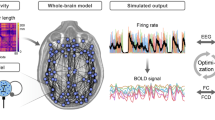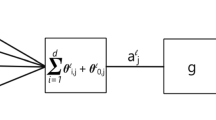Summary
Scalp potentials generated by a concentrated electric source in the brain are very similar to potentials generated by an electric dipole at the source position. In this sense a concentrated source in the brain is modelled as an electric dipole. When the source is diffuse such a dipole which best approximates the scalp potential is called an optimal dipole. Its position is calculated by the Dipole Tracing Method based on a realistic head model with homogeneous electric conductivity. There are 2 major difficulties inherent in this method: (1) The low electric conductivity of the skull causes systematic shifts of the optimal dipole positions from the true positions of concentrated sources; (2) the optimal dipoles cannot specify diffuse source positions. The first difficulty is overcome by using the numerical correction obtained by comparing the known dipole positions generated within a human head with their optimal ones. The second difficulty is removed to a certain extent by comparing the optimal dipole positions obtained with the 1-dipole and 2-dipole models together with their dipolarity. We have obtained criteria for the validity of the dipole approximation and source concentration.
Similar content being viewed by others
References
Ary, J.P., Klein, S.A. and Fender, D.H. Location of sources of evoked potentials: corrections for skull and scalp thickness. IEEE Trans. Biomed. Eng., 1981, BME-28: 447–452.
He, B., Musha, T., Okamoto, Y., Homma, S., Nakajima, Y. and Sato, T. Electric dipole tracing in the brain by means of the boundary element method and its accuracy. IEEE Trans. Biomed. Eng., 1987, BME-34: 406–414.
He, B. and Musha, T. Effects of cavities on EEG dipole localization and their relations with surface electrode positions, Int. J. Biomed. Comput., 1989, 24: 269–282.
Homma, S. and Musha, T. New imaging method of brain functions- Evoked potentials in human brain. Nakayama Shoten. In: Taisha, 1989, 26: 67–72.
Homma, S., Nakajima, Y., Musha, T., Okamoto, Y., Hagbarth,K.-E., Blom, S. and Flink, R. Generator mechanism of epileptic potentials analyzed by dipole tracing method, Neuroscience Letters, 1990, 113: 181–186.
Homma, S., Nakajima, Y., Musha, T., He, B. and Okamoto, Y. Dipole-tracing of ‘awareness’ attenuating the cortical components of somatosensory evoked potentials. Neuroscience Letters, 1988, 88: 257–262.
Musha, T. and Takakura, K. Diagnosis of epileptic focus by means of the dipole tracing (DT) method. In: K. Takakura (Ed.), Recent Examinations for Neurological Disorders. Gendai Iryousha, Tokyo, 1989: 183–192.
Nakajima, Y., Homma, S., Musha, T., Okamoto, Y., Ackerman, R.H., Correia, J.A. and Alpert, N.M. Dipole tracing of abnormal slow brain potentials after cerebral stroke-EEG, PET, MRI correlations. Neuroscience Letters, 1990, 112: 59–64.
Rush, S. and Driscoll, D.A. Current distribution in the brain from surface electrodes. Anesthesia and Analgesia, Current Researches, 1968, 47: 717–723.
Rush, S. and Driscoll, D.A. EEG electrode resistivity - An application of reciprocity. IEEE Trans. Biomed. Eng., 1969, BME-16: 15–22.
Author information
Authors and Affiliations
Additional information
The authors thank Professor K.-E. Hagbarth, Professor S. Blom and Dr. R. Flink of Uppsala University Hospital; Dr. M. Seino of the National Epilepsy Center, Shizuoka; and Professor Y. Okamoto of Chiba Inst. Technology. Supported in part by Int. Scientific Research Programs (Joint Research) of the Ministry of Education, No. 01044026 and No. 02044054 and the Nissan Science Foundation.
Rights and permissions
About this article
Cite this article
Musha, T., Homma, S. Do optimal Dipoles obtained by the Dipole Tracing Method slways suggest true source locations?. Brain Topogr 3, 143–150 (1990). https://doi.org/10.1007/BF01128871
Issue Date:
DOI: https://doi.org/10.1007/BF01128871




